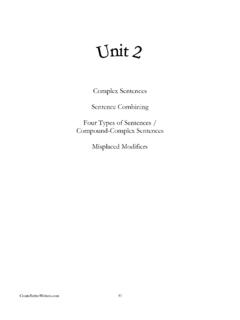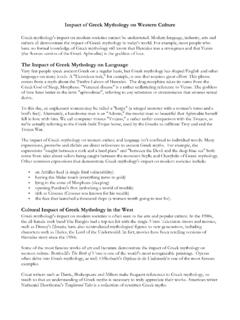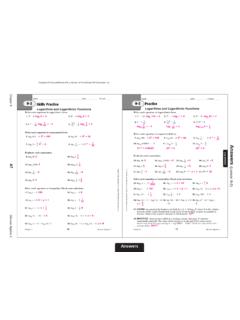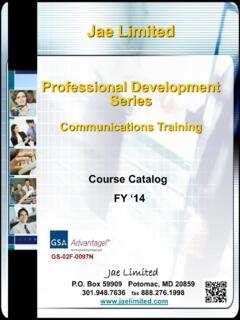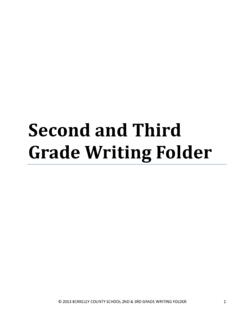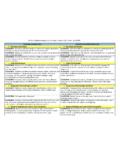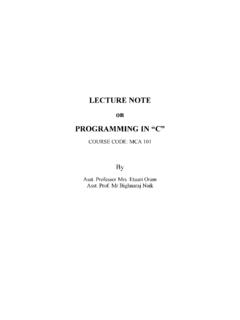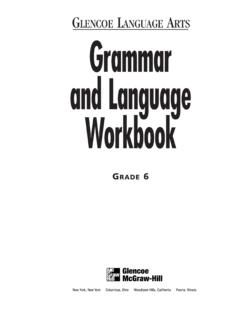Transcription of Grammar and Language Workbook
1 GLENCOELANGUAGEARTSG rammar and LanguageWorkbookGRADE11 Copyright by The McGraw-Hill Companies, Inc. All rights reserved. Except as permitted under the United StatesCopyright Act of 1976, no part of this publication may be reproduced or distributed in any form or means, or stored ina database or retrieval system, without the prior written permission of the all inquiries to:Glencoe/McGraw-Hill936 Eastwind DriveWesterville, Ohio 43081 ISBN 0-02-818303-7 Printed in the United States of America1 2 3 4 5 6 7 8 9 10 047 03 02 01 00 99 Glencoe/McGraw-HillHandbook of Definitions and Rules ..1 Troubleshooter ..21 Part 1 Grammar ..45 Unit 1 Parts of : Concrete and Abstract .. : Proper, Common, and : Personal, Possessive, Reflexive,and Intensive .. : Demonstrative, Interrogative,Relative, and : : Linking .. Phrases .. : Coordinating, Correlative, and Adverbs and Interjections ..69 Unit 1 Review ..71 Cumulative Review Unit 1 ..72 Unit 2 Parts of the and Predicates .. Subjects and Predicates.
2 Of Subject and and Indirect Objects .. and Subject 2 Review ..83 Cumulative Review: Units 1 3 Phrases .. , Participial Phrases, and Absolute and Gerund Phrases; Appositivesand Appositive Phrases .. and Infinitive Phrases .. Participial, Gerund, andInfinitive Phrases ..93 Unit 3 Review ..95 Cumulative Review: Units 1 4 Clauses and Sentence and Subordinate Clauses .. and Compound Sentences .. and Compound-Complex Clauses .. of Fragments .. 4 Review ..115 Cumulative Review: Units 1 4 ..116 Unit 5 Diagraming Simple Sentences .. Simple Sentences with Phrases .. Sentences with 5 Review ..127 Cumulative Review: Units 1 6 Verb Tenses, Voice, and Verbs: Principal Parts .. Verbs: Principal Parts .. of Verbs: Present, Past, and Future .. Tenses: Present, Past, and Future .. of Verbs .. : Progressive and Emphatic Forms .. : Compatibility of of Verbs .. of Verbs ..147 Unit 6 Review ..149 Cumulative Review: Units 1 6 ..150 Unit 7 Subject-Verb Agreement.
3 Prepositional Phrases .. with Linking in Inverted with Special Subjects .. with Compound Pronouns as Subjects .. in Adjective 7 Review ..171 Cumulative Review: Units 1 8 Using Pronouns of Personal Pronouns .. with and as Appositives; After Thanand and Intensive Pronouns .. Whom in Questions andSubordinate in Number and Gender and with Collective Nouns .. in with Indefinite Pronoun Reference ..189 Unit 8 Review ..191 Cumulative Review: Units 1 9 Using Modifiers : Three Degrees of Comparison .. : Irregular of ContentsiiiCopyright by : Double and Goodor Well; Bador and Dangling Modifiers ..207 Unit 9 Review ..211 Cumulative Review: Units 1 2 Usage ..215 Unit 10 Usage Usage: ato Usage: allusiontowould Usage: different from to Usage: this kindto reason is Usage: respectfully to 10 Review ..227 Cumulative Review: Units 1 10 ..228 Part 3 Mechanics ..231 Unit 11 Capitalization of Sentences and the Pronoun Capitalization of Proper Nouns.
4 Capitalization of Proper 11 Review ..239 Cumulative Review: Units 1 11 ..240 Unit 12 Punctuation, Abbreviations, and End Punctuation: Period, Exclamation Point,and Question Colons .. Semicolons .. Commas and Compound Sentences .. Commas in a Series and between Coordinate Commas and Nonessential Elements withInterjections, Parenthetical Expressions, and Conjunctive Adverbs .. Commas and Introductory Commas and Adverb Clauses andAntithetical Phrases .. Commas with Titles, Addresses, andNumbers .. Commas and Direct Address and in TagQuestions and Letter Writing .. Misused Commas .. Commas in Dashes to Signal Change and to Emphasize .. Parentheses, Brackets, and Ellipsis Points .. Quotation Marks for Direct Quotations .. Quotation Marks with Titles of Short Works,Unusual Expressions, Definitions, and withOther Marks of Punctuation .. Italics .. The The Abbreviations .. Numbers and Numerals ..283 Unit 12 Review.
5 285 Cumulative Review: Units 1 12 ..286 Part 4 Vocabulary and Spelling ..289 Unit 13 Vocabulary and Building Vocabulary: Learning from Building Vocabulary: Word Building Vocabulary: Prefixes and Basic Spelling Rules: I .. Basic Spelling Rules: II ..299 Review: Building Vocabulary ..301 Review: Basic Spelling Rules ..303 Part 5 14 The Writing Process: Prewriting .. The Writing Process: Drafting .. The Writing Process: Revising .. The Writing Process: Editing .. The Writing Process: Presenting .. Outlining .. Writing Effective Sentences .. Building Paragraphs .. Paragraph Ordering .. Personal Letters .. Business Letters: Letters of Request or Business Letters: R sum s and Cover Letters ..339 Index ..343 TAE TestsUnit 1: Parts of 2: Parts of the 3: 4: Clauses and Sentence Structure ..357 Unit 5: Diagraming 6: Verb Tenses, Voice, and 7: Subject-Verb Agreement ..367 Unit 8: Using Pronouns 9: Using Modifiers Correctly.
6 371 Unit 10: Usage ..373 Unit 11: Capitalization ..375 Unit 12: Punctuation, Abbreviations, and Numbers ..377 Unit 13: Vocabulary and Spelling ..381 Unit 14: Composition ..383 Answer Glencoe Grammar and Language Workbook , Grade 11 Copyright by Glencoe/McGraw-HillHandbook1 Handbook ofDefinitionsand Rules2 Glencoe Grammar and Language Workbook , Grade 11 Copyright by Glencoe/McGraw-HillHandbookPARTS OF singular nounis a word that names one person, place, thing, or idea: brother, classroom,piglet, and joy. A plural nounnames more than one person, place, thing, or idea: brothers,classrooms, piglets, and help you determine whether a word in a sentence is a noun, try adding it to the followingsentences. Nouns will fit in at least one of these sentences:I know something about know something about a(n) know something about know something about a collective nounnames a group. When the collective noun refers to the group as a whole, it issingular. When it refers to the individual group members, the collective noun is class meets two days a week.
7 (singular)The board of trustees come from all walks of life. (plural) common nounnames a general class of people, places, things, or ideas: soldier, country,month, or theory. A proper nounspecifies a particular person, place, thing, event, or nouns are always capitalized: General Schwartzkopf, America, July, or Big concrete nounnames an object that occupies space or that can be recognized by any of thesenses: tuba, music, potato, and aroma. An abstract nounnames an idea, a quality, or acharacteristic: courage, sanity, power, and possessive nounshows possession, ownership, or the relationship between two nouns:Raul s house, the cat s fur, and the girls soccer pronoun takes the place of a noun, a group of words acting as a noun, or another personal pronounrefers to a specific person or thing. First personpersonal pronouns referto the speaker, second personpronouns refer to the one spoken to, and third personpronounsrefer to the one spoken CasePossessive CaseObjective CaseFirst Person, SingularImy, minemeFirst Person, Pluralweour, oursusSecond Person, Singularyouyour, yoursyouSecond Person, Pluralyouyour, yoursyouThird Person, Singularhe, she, ithis, her, hers, itshim, her, itThird Person, Pluraltheytheir, reflexive pronounrefers to the subject of the sentence.
8 An intensive pronounadds emphasisto a noun or another pronoun. A demonstrative pronounpoints out specific persons, places,things, or :They psyched themselves up for the football :Freddie himself asked Julie :That is a good idea!Those are my interrogative pronounis used to form questions. A relative pronounis used to introduce asubordinate clause. An indefinite pronounrefers to persons, places, or things in a more generalway than a noun :Which is your choice?With whom were you playing video games?Handbook3 Copyright by Glencoe/McGraw-HillHandbookRelative:The cake that we baked was :Everyone has already oneshould enter without antecedent of a pronoun is the word or group of words referred to by the rode his bike to school. (Benis the antecedent of his.) verb is a word that expresses action or a state of being and is necessary to make a verbs will fit one or more of these sentences:We _____ _____ _____ .We remain love it!It action verbtells what someone or something does.
9 The two types of action verbs aretransitive and intransitive. A transitive verbis followed by a word or words that answer thequestion what? or whom?An intransitive verbis not followed by a word that answers what? orwhom?Transitive: Children trust their puppy carried the bone : The team played light burned linking verblinks, or joins, the subject of a sentence with an adjective, a noun, or a concert was loud. (adjective) I am a good card player. (noun) verb phraseconsists of a main verb and all its auxiliary, or helping, stomach has been growlingall am waitingfor a have four principal partsor forms: base, past, present participle, and past :I Participle: I am :I Participle:I have principal parts are used to form six verb tenses. The tense of a verb expresses TensesPresent Tense:She eats. (present or habitual action)Past Tense:She ate. (action completed in the past)Future Tense:She will eat. (action to be done in the future)Perfect TensesPresent Perfect Tense: She has eaten.
10 (action done at some indefinate time or still in effect)Past Perfect Tense:She had eaten.(action completed before some other past action)Future Perfect Tense:She will have eaten.(action to be completed before some future time) verbsform their past and past participle without adding -ed to the base PARTS OF IRREGULAR VERBSBasePastPast Participlebewas, werebeenbeatbeatbeatenbecomebecamebecome beginbeganbegunbitebitbitten or bitblowblewblownbreakbrokebrokenbringbro ughtbroughtBasePastPast Participlecatchcaughtcaughtchoosechosech osencomecamecomedodiddonedrawdrewdrawndr inkdrankdrunkdrivedrovedriveneatateeaten 4 Glencoe Grammar and Language Workbook , Grade 11 Copyright by formsof verbs, combined with a form of be, express a continuing action. Emphaticforms, combined with a form of do, add emphasis or form is scratchingthe has been washingthe do support our hometown heroes. (present)He did want that dinner. (past) voice of a verb shows whether the subject performs the action or receives the action of theverb.
